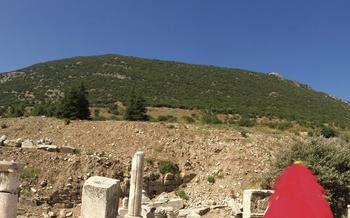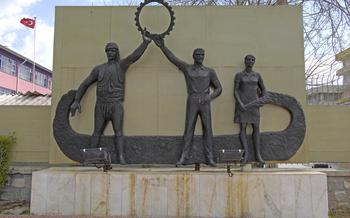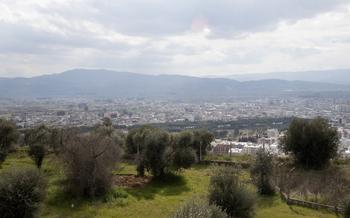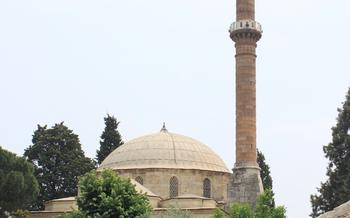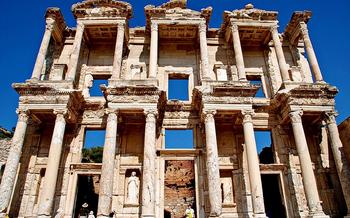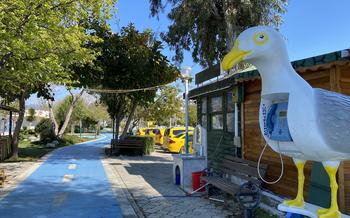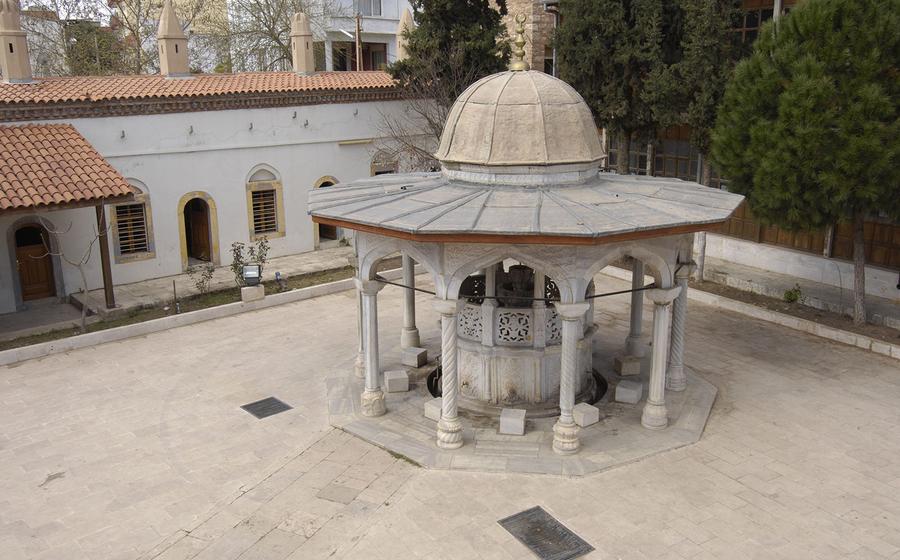
Neopolis Ancient City
- Historical Background:
- Location and Accessibility:
- Admission and Fees:
- Best Time to Visit
- What to See
- Things to Do
- Tips for Visitors:
- Photography
- History and Culture
- Architecture and Design
- Local Cuisine
- Souvenirs and Shopping
- Nearby Attractions
- Accommodation Options
- Insider Tip: Unveiling the Hidden Sanctuary
Historical Background:
Neopolis Ancient City, nestled in the heart of Aydın, Turkey, boasts a rich and storied past that dates back to the Hellenistic period. Founded in the 3rd century BC by Antiochus III the Great, Neopolis served as a strategic trading hub and a cultural center throughout the Roman and Byzantine eras. Its location at the crossroads of major trade routes made it a prosperous city, attracting merchants and visitors from across the region. During the Roman Empire, Neopolis flourished, becoming a prominent city in the province of Asia. However, its fortunes declined with the rise of Christianity and the eventual fall of the Roman Empire. Abandoned in the 7th century AD, Neopolis' ruins lay buried beneath layers of earth and vegetation, waiting to be rediscovered centuries later.
Location and Accessibility:
Neopolis Ancient City is situated in the Söke district of Aydın, Turkey, approximately 50 kilometers south of the city of Aydın. It is easily accessible by road, with well-maintained highways connecting it to major cities and towns in the region. Visitors can take public transportation, such as buses or minibuses, from Aydın or Söke directly to the site. Private vehicles are also a convenient option, with ample parking facilities available near the entrance. Neopolis Ancient City is wheelchair accessible, ensuring that visitors with disabilities can explore the site with ease.
Admission and Fees:
Visiting Neopolis Ancient City requires an entrance fee, which is typically reasonable and affordable for most visitors. The fee helps support the preservation and maintenance of the site, ensuring its continued accessibility for future generations. Students, seniors, and families can often enjoy discounted rates, making it a budget-friendly destination for educational and family outings. Guided tours are available for those who seek a deeper understanding of the site's history and significance, with additional charges applying. These tours offer a more immersive experience, providing insights and anecdotes from knowledgeable guides who bring the ancient city to life.
Best Time to Visit
The ideal time to visit Neopolis Ancient City is during the shoulder seasons of spring (April-May) and fall (September-October). During these months, the weather is generally pleasant, with warm days and cool nights, making it comfortable for exploring the site. Additionally, the crowds are smaller compared to the peak summer months, ensuring a more relaxed and enjoyable experience.
Spring offers the advantage of witnessing the surrounding countryside in full bloom, with wildflowers and greenery adding a vibrant touch to the ancient ruins. The mild temperatures are perfect for long walks and leisurely exploration of the site. However, it's worth noting that spring can be a rainy season in Turkey, so it's advisable to pack a raincoat or umbrella.
In contrast, fall brings a golden hue to the landscape as the leaves change color. The crisp autumn air is ideal for photography enthusiasts seeking stunning shots of the ancient city bathed in warm light. While the weather is generally mild, it's essential to be prepared for occasional showers.
Visiting Neopolis Ancient City during the summer months (June-August) can be challenging due to the intense heat and large crowds of tourists. The scorching sun can make exploring the site uncomfortable, and the throngs of visitors can diminish the tranquility and charm of the ancient ruins. However, if you're willing to brave the heat, early mornings and late afternoons offer more bearable temperatures for exploring.
Winter (November-March) is generally not the best time to visit Neopolis Ancient City. The weather can be cold and unpredictable, with occasional rain or even snow. Some parts of the site may be closed or inaccessible due to adverse weather conditions. However, if you're looking for a more solitary experience, the winter months offer a unique opportunity to explore the ancient city in relative peace and tranquility.
What to See
Neopolis Ancient City boasts a wealth of captivating attractions that transport visitors back in time. The well-preserved theater, with its impressive seating capacity, is a must-see for history enthusiasts. Its architectural details and acoustics provide a glimpse into the city's vibrant entertainment scene.
The agora, once the bustling marketplace and social hub of Neopolis, invites visitors to explore its remnants. Here, they can imagine the lively atmosphere as merchants traded goods and citizens gathered for social interactions and civic affairs.
Religious and spiritual life played a significant role in Neopolis, as evidenced by the remains of several temples. These sacred structures, dedicated to various deities, offer insights into the religious practices and beliefs of the ancient inhabitants.
The imposing city walls, once a formidable defense system, stand as a testament to the city's strategic importance. Visitors can trace the perimeter of the walls and admire the intricate construction techniques employed to protect Neopolis from invaders.
Beyond these major attractions, Neopolis Ancient City conceals hidden gems waiting to be discovered. Scattered throughout the site are remnants of houses, workshops, and other structures that provide a glimpse into the daily lives of its inhabitants. Visitors can explore these lesser-known areas to gain a deeper understanding of the city's layout and social organization.
Things to Do
At Neopolis Ancient City, visitors can immerse themselves in history and culture through various activities and experiences. Photography enthusiasts can capture stunning shots of the well-preserved ruins, including the theater, agora, temples, and city walls. Exploring the site on foot allows visitors to discover hidden corners, admire intricate architectural details, and appreciate the scale and grandeur of this once-thriving city. Guided tours are available for those who prefer a more in-depth understanding of the site's history and significance. Self-guided walks are also a great option for independent travelers who wish to explore at their own pace. Visitors can also learn about the ancient city's rich history and culture through informative panels and displays located throughout the site.
Tips for Visitors:
To ensure an enriching and enjoyable experience at Neopolis Ancient City, consider these practical tips:
-
Comfortable Footwear: Wear comfortable walking shoes or sandals, as the ancient city involves navigating uneven terrain and cobblestone paths.
-
Hydration and Snacks: Bring sufficient water and snacks, as there are limited food and beverage options available on-site.
-
Sun Protection: Carry sunscreen, a hat, and sunglasses to protect yourself from the sun's intensity, especially during the summer months.
-
Camera and Accessories: Bring a camera to capture the stunning views and intricate architectural details. Consider bringing a tripod for stable shots and a wide-angle lens for panoramic views.
-
Guided Tours: Guided tours are available at Neopolis Ancient City, providing insights into the site's history and significance. Consider booking a tour to enhance your understanding of the ancient ruins.
-
Self-Guided Walks: For a more intimate experience, opt for a self-guided walk. Download maps or guidebooks to navigate the site at your own pace and explore hidden corners.
-
Respectful Behavior: Remember that Neopolis Ancient City is a historical site. Be respectful of the ruins and refrain from touching or climbing on them.
-
Photography Etiquette: Be mindful of other visitors when taking photos. Avoid blocking pathways or obstructing others' views.
Photography
Neopolis Ancient City offers a treasure trove of photographic opportunities for enthusiasts of all levels. Capture the grandeur of the ancient theater with its sweeping rows of stone seats, or zoom in on the intricate carvings and bas-reliefs that adorn the city's temples and monuments. The well-preserved city walls provide a stunning backdrop for panoramic shots, while the natural beauty of the surrounding landscape adds depth and context to your images.
For the best lighting conditions, plan your visit during the golden hours of sunrise or sunset, when the warm hues of the sky cast a magical glow on the ancient ruins. Don't forget to experiment with different angles and perspectives to capture unique and creative shots. Whether you're a seasoned photographer or just starting out, Neopolis Ancient City is a place where you can unleash your creativity and capture the essence of history through the lens of your camera.
History and Culture
Neopolis Ancient City holds immense historical and cultural significance. It served as a crucial trading hub and cultural center during the Roman and Byzantine periods. The city's strategic location along the ancient trade routes allowed it to flourish as a commercial center, facilitating the exchange of goods and ideas between different regions.
Neopolis's rich history is evident in its well-preserved ruins, which offer a glimpse into the city's vibrant past. The remains of temples, theaters, and public buildings speak volumes about the city's cultural and religious practices. Visitors can admire the intricate mosaics and sculptures that adorn these structures, providing a tangible connection to the city's artistic heritage.
One of the most notable historical figures associated with Neopolis is the Roman orator and philosopher Cicero. During his exile from Rome, Cicero is believed to have spent time in Neopolis, where he wrote several of his philosophical works. This connection to Cicero adds another layer of historical significance to the site.
Exploring Neopolis Ancient City is a journey through time, allowing visitors to immerse themselves in the rich tapestry of Roman and Byzantine history, culture, and traditions.
Architecture and Design
The architectural features and design elements of Neopolis Ancient City are a testament to the ingenuity and skill of the ancient builders. Constructed primarily using local materials such as stone and marble, the city showcases a unique blend of Roman and Greek architectural styles. The city walls, which once provided protection, are a remarkable example of defensive architecture.
Neopolis' theater is a particularly impressive structure, featuring a well-preserved stage and seating area. The theater's acoustics are excellent, allowing performers to be heard clearly from all corners of the auditorium. The agora, or marketplace, is another significant architectural feature. This large open space was the center of commercial activity and social interaction, lined with shops and stalls. The temples, dedicated to various deities, showcase intricate carvings and decorative elements, providing a glimpse into the religious beliefs and practices of the city's inhabitants.
As you explore Neopolis Ancient City, pay attention to the intricate details and architectural elements that make it unique. From the finely carved friezes to the elegant columns, each structure tells a story of the city's past.
Local Cuisine
After exploring the ancient ruins, indulge in the culinary delights of the region. Savor traditional Turkish cuisine at local restaurants or eateries near Neopolis Ancient City. Don't miss the opportunity to try "Aydın Kuyucuk Elması," a unique variety of apple grown exclusively in the Aydın region. These apples are renowned for their sweet and juicy flavor, making them a must-try for fruit enthusiasts.
For a taste of local specialties, try "Aydın Çöp Şiş," a flavorful skewer dish made with tender lamb or chicken pieces grilled to perfection. Another local delicacy is "Aydın Köftesi," delicious meatballs made with a blend of spices and herbs, often served with a tangy tomato sauce.
To satisfy your sweet tooth, try "Aydın İncirli Kek," a delectable fig cake made with fresh figs, walnuts, and a hint of cinnamon. This traditional dessert is a beloved treat among locals and visitors alike.
When dining in Aydın, don't forget to sample the region's famous olive oil. Aydın is known for producing some of the finest olive oil in Turkey, thanks to its favorable climate and fertile soil. Look for local olive oil shops or markets to purchase a bottle of this liquid gold to take home as a souvenir.
Souvenirs and Shopping
Neopolis Ancient City and the surrounding area offer a range of shopping opportunities for visitors looking for souvenirs and local products. In the nearby towns and villages, you can find shops selling traditional Turkish handicrafts, such as carpets, pottery, and jewelry. These items make excellent souvenirs to remind you of your trip to Neopolis and the region.
For those seeking unique and authentic souvenirs, the local markets are a great place to start. Here, you can find a variety of handmade goods, including textiles, leatherwork, and copperware. Bargaining is expected in these markets, so don't be afraid to haggle for a good price.
If you're looking for something truly special, consider purchasing a piece of Neopolis-inspired pottery. The region is renowned for its high-quality ceramics, and you can find a wide variety of items to choose from, including decorative plates, vases, and figurines.
When shopping for souvenirs, remember to support local artisans and businesses. By purchasing handmade goods, you not only take home a unique memento but also contribute to the preservation of traditional crafts and the local economy.
Nearby Attractions
In addition to exploring the ancient ruins of Neopolis, visitors can venture into the surrounding region to discover a wealth of other captivating attractions. Just a short drive away lies the charming town of Kuşadası, renowned for its picturesque harbor, bustling bazaars, and pristine beaches. History buffs can delve deeper into the region's past at the Kuşadası Castle, a well-preserved fortress that offers breathtaking panoramic views of the Aegean Sea.
Nature enthusiasts will find solace in the nearbyDilek Peninsula National Park, a stunning expanse of protected land that boasts pristine beaches, lush forests, and a diverse array of flora and fauna. For a unique perspective of the region, embark on a boat tour from Kuşadası harbor and marvel at the stunning coastline, dotted with secluded coves and hidden inlets.
Art and history converge at the Ephesus Museum, located in the nearby town of Selçuk. This world-renowned museum houses a treasure trove of artifacts unearthed from the ancient city of Ephesus, providing a glimpse into the region's rich past. From awe-inspiring sculptures to intricate mosaics, the Ephesus Museum offers a captivating journey through time.
Plan a comprehensive itinerary that allows you to seamlessly blend the exploration of Neopolis Ancient City with visits to these nearby attractions. Immerse yourself in the region's captivating history, revel in the beauty of nature, and indulge in the vibrant culture that defines this enchanting corner of Turkey.
Accommodation Options
When planning your trip to Neopolis Ancient City, you'll find a range of accommodation options to suit different budgets and preferences. For those seeking a comfortable and convenient stay, the nearby town of Aydın offers a variety of hotels and guesthouses. Alternatively, if you prefer a more immersive experience, consider staying in one of the charming villages surrounding the ancient city. These villages offer traditional Turkish hospitality and provide an opportunity to connect with the local culture.
For budget-conscious travelers, hostels and guesthouses offer affordable options with basic amenities. Mid-range hotels provide a comfortable stay with modern conveniences, while luxury resorts cater to those seeking a truly indulgent experience. Whichever accommodation you choose, be sure to book in advance, especially during the peak tourist season, to avoid disappointment.
Insider Tip: Unveiling the Hidden Sanctuary
Beyond the well-trodden paths of Neopolis Ancient City lies a hidden sanctuary, a place of tranquility and wonder that few visitors stumble upon. Nestled amidst the ruins, concealed by overgrown foliage, is a secluded grotto adorned with ancient inscriptions and carvings. This secret chamber, believed to have served as a sacred retreat for the city's inhabitants, exudes an aura of mystery and invites visitors to step back in time.
To discover this hidden gem, venture off the main path and follow a narrow, winding trail that leads deeper into the ancient city. As you approach the grotto, the air becomes still, and a sense of awe washes over you. The walls of the chamber are etched with intricate symbols and figures, telling tales of forgotten rituals and beliefs. In the center of the grotto, a small altar stands, inviting you to sit and contemplate the passage of time.
Take a moment to absorb the serenity of this hidden sanctuary. Let your imagination transport you back to the days when Neopolis thrived, and its people sought solace and guidance within these sacred walls. As you leave the grotto, carry with you a sense of wonder and appreciation for the hidden treasures that await those who dare to explore beyond the surface.
